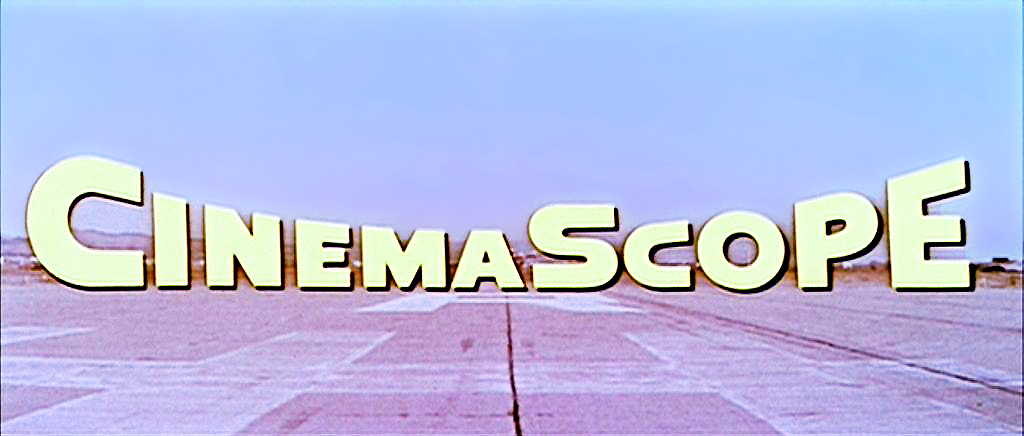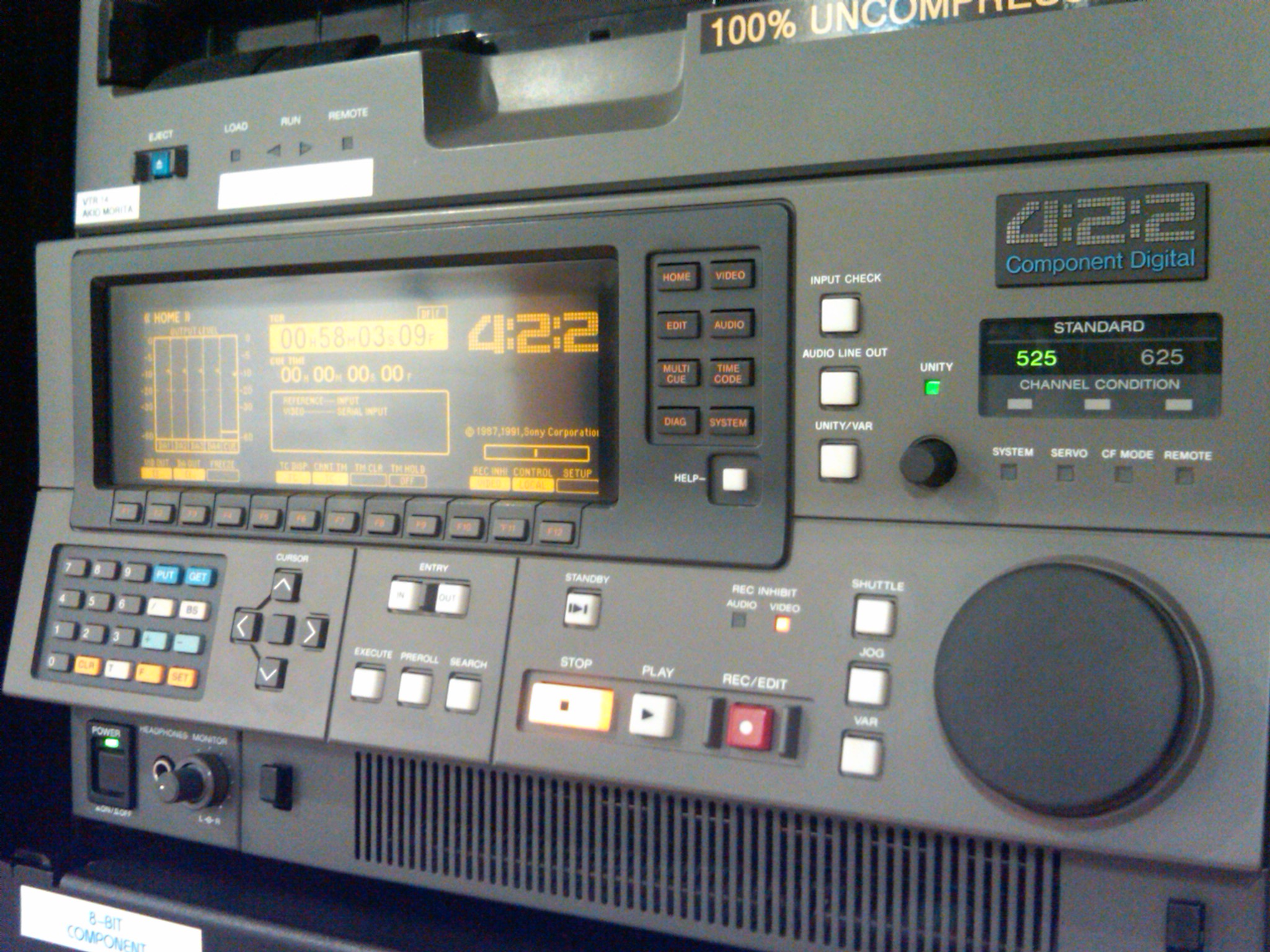|
Anamorphic Widescreen
Anamorphic widescreen (also called full-height anamorphic or FHA) is a process by which a widescreen image is horizontally compressed to fit into a storage medium (photographic film or MPEG-2 standard-definition frame, for example) with a narrower aspect ratio, reducing the horizontal resolution of the image while keeping its full original vertical resolution. Compatible play-back equipment (a projector with modified lens, or a digital video player or set-top box) can then expand the horizontal dimension to show the original widescreen image. This is typically used to allow one to store widescreen images on a medium that was originally intended for a narrower ratio, while using as much of the frame – and therefore recording as much detail – as possible. The technique comes from cinema, when a film would be framed and recorded as widescreen but the picture would be "squashed together" using a special concave lens to fit into non-widescreen 1.37:1 aspect ratio film. ... [...More Info...] [...Related Items...] OR: [Wikipedia] [Google] [Baidu] |
Illustration Anamorph Letterbox
An illustration is a decoration, interpretation, or visual explanation of a text, concept, or process, designed for integration in print and digitally published media, such as posters, Flyer (pamphlet), flyers, magazines, books, teaching materials, animations, video games and films. An illustration is typically created by an illustrator. Digital illustrations are often used to make websites and apps more user-friendly, such as the use of emojis to accompany digital type. Illustration also means providing an example; either in writing or in picture form. The origin of the word "illustration" is late Middle English (in the sense ‘illumination; spiritual or intellectual enlightenment’): via Old French from Latin ''illustratio''(n-), from the verb ''illustrare''. Illustration styles Contemporary illustration uses a wide range of styles and techniques, including drawing, painting, printmaking, collage, Photomontage, montage, Interaction design, digital design, multimedia, 3 ... [...More Info...] [...Related Items...] OR: [Wikipedia] [Google] [Baidu] |
CinemaScope
CinemaScope is an anamorphic format, anamorphic lens series used, from 1953 to 1967, and less often later, for shooting widescreen films that, crucially, could be screened in theatres using existing equipment, albeit with a lens adapter. Its creation in 1953 by Spyros Skouras, Spyros P. Skouras, the president of 20th Century Fox, marked the beginning of the modern anamorphic format in both principal Aspect ratio (image), 2.55:1, almost twice as wide as the previously common Academy format's 1.37:1 ratio. Although the technology behind the CinemaScope lens system was made obsolete by later developments, primarily advanced by Panavision, CinemaScope's anamorphic format has continued to this day. In film-industry jargon, the shortened form, 'Scope, is still widely used by both filmmakers and projectionists, although today it generally refers to any Anamorphic format, 2.35:1, 2.39:1, 2.40:1, or 2.55:1 presentation or, sometimes, the use of anamorphic lensing or projection in general. ... [...More Info...] [...Related Items...] OR: [Wikipedia] [Google] [Baidu] |
Digital Television
Digital television (DTV) is the transmission of television signals using Digital signal, digital encoding, in contrast to the earlier analog television technology which used analog signals. At the time of its development it was considered an innovative advancement and represented the first significant evolution in television technology since color television in the 1950s. Modern digital television is transmitted in high-definition television (HDTV) with greater resolution than analog TV. It typically uses a widescreen aspect ratio (commonly 16:9) in contrast to the narrower format (4:3) of analog TV. It makes more economical use of scarce radio spectrum space; it can transmit up to seven channels in the same Bandwidth (signal processing), bandwidth as a single analog channel, and provides many new features that analog television cannot. A digital television transition, transition from analog to digital broadcasting began around 2000. Different digital television broadcasting st ... [...More Info...] [...Related Items...] OR: [Wikipedia] [Google] [Baidu] |
Technical Specifications
A specification often refers to a set of documented requirements to be satisfied by a material, design, product, or service. A specification is often a type of technical standard. There are different types of technical or engineering specifications (specs), and the term is used differently in different technical contexts. They often refer to particular documents, and/or particular information within them. The word ''specification'' is broadly defined as "to state explicitly or in detail" or "to be specific". A requirement specification is a documented requirement, or set of documented requirements, to be satisfied by a given material, design, product, service, etc. It is a common early part of engineering design and product development processes in many fields. A functional specification is a kind of requirement specification, and may show functional block diagrams. A design or product specification describes the features of the ''solutions'' for the Requirement Specification, ... [...More Info...] [...Related Items...] OR: [Wikipedia] [Google] [Baidu] |
D-1 (Sony)
D-1 or 4:2:2 Component Digital is an SMPTE digital recording video standard, introduced in 1986 through efforts by SMPTE engineering committees. It started as a Sony and Bosch – BTS product and was the first major professional digital video format. SMPTE standardized the format within ITU-R 601 (orig. CCIR-601), also known as Rec. 601, which was derived from SMPTE 125M and EBU 3246-E standards. Format D-1 or 4:2:2 D-1 (1986) was a major feat in real time, broadcast quality digital video recording. It stores uncompressed digitized component video, encoded at Y'CbCr 4:2:2 using the CCIR 601 raster format with 8 bits, along with PCM audio tracks as well as timecode on a 3/4 inch (19 mm) videocassette tape (though not to be confused with the ubiquitous 3/4-inch U-Matic/U-Matic SP cassette). The uncompressed component video used enormous bandwidth for its time: 167 Mbit/sec (bit rate). One of the first D-1 VTRs, the Sony DVR-1000, required a separa ... [...More Info...] [...Related Items...] OR: [Wikipedia] [Google] [Baidu] |
Video
Video is an Electronics, electronic medium for the recording, copying, playback, broadcasting, and display of moving picture, moving image, visual Media (communication), media. Video was first developed for mechanical television systems, which were quickly replaced by cathode-ray tube (CRT) systems, which, in turn, were replaced by flat-panel displays of several types. Video systems vary in display resolution, Display aspect ratio, aspect ratio, refresh rate, color capabilities, and other qualities. Analog and digital variants exist and can be carried on a variety of media, including radio broadcasts, magnetic tape, optical discs, Video file format, computer files, and Streaming media, network streaming. Etymology The word ''video'' comes from the Latin verb ''video,'' meaning to see or ''videre''. And as a noun, "that which is displayed on a (television) screen," History Analog video Video developed from facsimile systems developed in the mid-19th century. Early mecha ... [...More Info...] [...Related Items...] OR: [Wikipedia] [Google] [Baidu] |
Society Of Motion Picture And Television Engineers
The Society of Motion Picture and Television Engineers (SMPTE) (, rarely ), founded by Charles Francis Jenkins in 1916 as the Society of Motion Picture Engineers or SMPE, is a global professional association of engineers, technologists, and executives working in the media and entertainment industry. As an internationally recognized standards organization, SMPTE has published more than 800 technical standards and related documents for broadcast, filmmaking, digital cinema, audio recording, information technology (IT), and medical imaging. SMPTE also publishes the ''SMPTE Motion Imaging Journal'', provides networking opportunities for its members, produces academic conferences and exhibitions, and performs other industry-related functions. SMPTE membership is open to any individual or organization with an interest in the subject matter. In the US, SMPTE is a 501(c)(3) organization, 501(c)3 non-profit charitable organization. History An informal organizational meeting was hel ... [...More Info...] [...Related Items...] OR: [Wikipedia] [Google] [Baidu] |
Blu-ray Disc
Blu-ray (Blu-ray Disc or BD) is a Digital media, digital optical disc data storage format designed to supersede the DVD format. It was invented and developed in 2005 and released worldwide on June 20, 2006, capable of storing several hours of high-definition video (HDTV 720p and 1080p). The main application of Blu-ray is as a medium for video material such as feature films and for the physical distribution of video games for the PlayStation 3, PlayStation 4, PlayStation 5, Xbox One, and Xbox Series X and Series S, Xbox Series X. The name refers to the blue laser used to read the disc, which allows information to be stored at a greater density than is possible with the longer-wavelength red laser used for DVDs, resulting in an increased capacity. The polycarbonate disc is in diameter and thick, the same size as DVDs and Compact disc, CDs. Conventional (or "pre-BDXL") Blu-ray discs contain 25gigabyte, GB per layer, with dual-layer discs (50GB) being the industry standard for fe ... [...More Info...] [...Related Items...] OR: [Wikipedia] [Google] [Baidu] |
The Walt Disney Company
The Walt Disney Company, commonly referred to as simply Disney, is an American multinational mass media and entertainment conglomerate headquartered at the Walt Disney Studios complex in Burbank, California. Disney was founded on October 16, 1923, as an animation studio, by brothers Walt Disney and Roy Oliver Disney as Disney Brothers Cartoon Studio; it later operated under the names Walt Disney Studio and Walt Disney Productions before adopting its current name in 1986. In 1928, Disney established itself as a leader in the animation industry with the short film ''Steamboat Willie.'' The film used synchronized sound to become the first post-produced sound cartoon, and popularized Mickey Mouse, who became Disney's mascot and corporate icon. After becoming a success by the early 1940s, Disney diversified into live-action films, television, and theme parks in the 1950s. However, following Walt Disney's death in 1966, the company's profits, especially in the animation sector, ... [...More Info...] [...Related Items...] OR: [Wikipedia] [Google] [Baidu] |
Letterboxed
Letter-boxing is the practice of transferring film shot in a widescreen aspect ratio to standard-width video formats while preserving the film's original aspect ratio. The resulting video-graphic image has mattes of empty space above and below it; these mattes are part of each frame of the video signal. Etymology The term refers to the shape of a letter-box, a slot in a wall or door through which mail is delivered, being rectangular and wider than it is high. Early home video use The first use of letter-boxing in consumer video appeared with the RCA Capacitance Electronic Disc (CED) videodisc format. Initially, letter-boxing was limited to several key sequences of a film such as opening and closing credits, but was later used for entire films. The first fully letter-boxed CED release was '' Amarcord'', and several others followed including '' The Long Goodbye'', ''Monty Python and the Holy Grail'' and '' The King of Hearts''. Each disc contains a label noting the use of "R ... [...More Info...] [...Related Items...] OR: [Wikipedia] [Google] [Baidu] |






